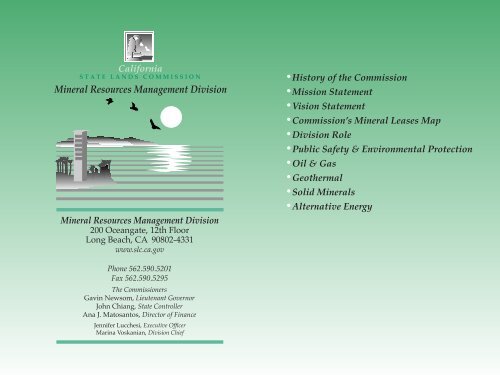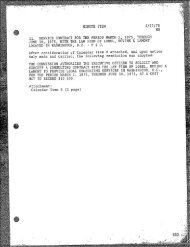Mineral Resources Management Division - State Lands Commission
Mineral Resources Management Division - State Lands Commission
Mineral Resources Management Division - State Lands Commission
- No tags were found...
You also want an ePaper? Increase the reach of your titles
YUMPU automatically turns print PDFs into web optimized ePapers that Google loves.
<strong>Division</strong> RoleThe <strong>Mineral</strong> <strong>Resources</strong> <strong>Management</strong> <strong>Division</strong> (MRMD) manages the development of energy andmineral resources on more than 130 oil, gas, geothermal and mineral leases covering more than 95,000acres of state-owned lands. The <strong>Division</strong>’s goals are to ensure public safety, protect the environment, andmaximize revenue. MRMD staff includes specialists in petroleum and structural engineering, geology,oil and gas and geothermal drilling and production operations, civil engineering, resource economics,mining and leasing.Public Safety & Environmental ProtectionMRMD is responsible for ensuring that mineral resources are developed in a way that protectspublic health and safety and the environment.Marine FacilityInspection ProgramMRMD emphasizes the prevention of accidents and environmentaldamage and conducts frequent inspections of equipment and facilitiesto ensure safe and environmentally friendly operations. Best availableprotection standards are used in the inspections and a rigorous safety andenvironmental audit program is used for assessment of facilities to insurethe use of best available technology and that best achievable protection ismaintained. Analyses of facilities and operations involve review of documentsprepared under the California Environmental Quality Act (CEQA),mitigation monitoring, engineering design review of structures, operationsand procedures reviews, maintenance programs, and compliancewith applicable standards and codes. The work of staff is often performedin coordination with other divisions within the agency and in conjunctionwith other responsible agencies such as the Department of Conservation,the Department of Fish and Game, the California Coastal <strong>Commission</strong>,and the federal Bureau of Ocean Energy <strong>Management</strong>, Bureau of Safetyand Environmental Enforcement and Bureau of Land <strong>Management</strong>. MRMD’s inspection andsafety/environmental review program is from inception to decommissioning for every facility oroperation on <strong>State</strong> lands.
wastewater. Two pipelines now transport 20 million gallons of water per day from surroundingcounties for injection at The Geysers, and operators have seen measurable increases in steam flowrate and generation, as well as improvements in steam chemistry due to the injection.Solid <strong>Mineral</strong>sDevelopment of solid mineral resources on <strong>State</strong> lands, particularly precious metals andindustrial minerals, generates revenue in the form of royalty and rent. At present, about$1,000,000 is collected annually. MRMD routinely reviews CEQA documents, mineral explorationand development plans, and mine reclamation plans in cooperation with the <strong>Commission</strong>’sEnvironmental Planning and <strong>Management</strong> <strong>Division</strong>. Since 2003, MRMD had workedcooperatively with the Department of Conservation to identify and reduce hazards to the publicand wildlife associated with old abandoned mines. Individual closures are performed only afterextensive consideration of cultural and biological resources. Bat gates, cupolas, foam plugs,backfills and signage are installed on a case by case basis following evaluation of biologic andhistoric attributes and the mines unique physical features.Alternative EnergyIn 2008, Governor Schwarzenegger issued an Executive Order establishing a <strong>State</strong> policy goalof producing 33% of California’s electrical needs with renewable energy by 2020. In 2011, AB982 (Skinner) directed the <strong>Commission</strong> to engage in a cooperative effort with the Departmentof the Interior through the Bureau of Land <strong>Management</strong> (BLM) to exchange fragmented Schoolland parcels into consolidating land holdings suitable for the development of alternative energyprojects. The <strong>Commission</strong> joined the Renewable Energy Action Team with other federal andstate agencies and is cooperatively working on the Desert Renewable Energy Conservation Plan(DRECP EIR/EIS) which will guide renewable energy project citing in the California DesertConservation Area. Alternative energy projects will consist of a combination of solar, wind andgeothermal energy. <strong>Commission</strong> staff is working with BLM on land exchanges so that alternativeenergy projects can be developed on <strong>State</strong> lands while the BLM acquires <strong>State</strong> school landinholdings within National Parks and Wilderness Areas. MRMD works cooperatively with the<strong>Commission</strong>’s Land <strong>Management</strong> <strong>Division</strong> to appraise and exchange <strong>State</strong> school lands includingmineral interests to ensure proper valuation is achieved for the <strong>State</strong> Teachers Retirement System.MRMD oversees the siting and construction of alternative energy projects on <strong>State</strong> lands to ensuretheir proper engineering while minimizing environmental impacts. These efforts should make asignificant contribution toward meeting the <strong>State</strong>’s alternative energy goals.
















